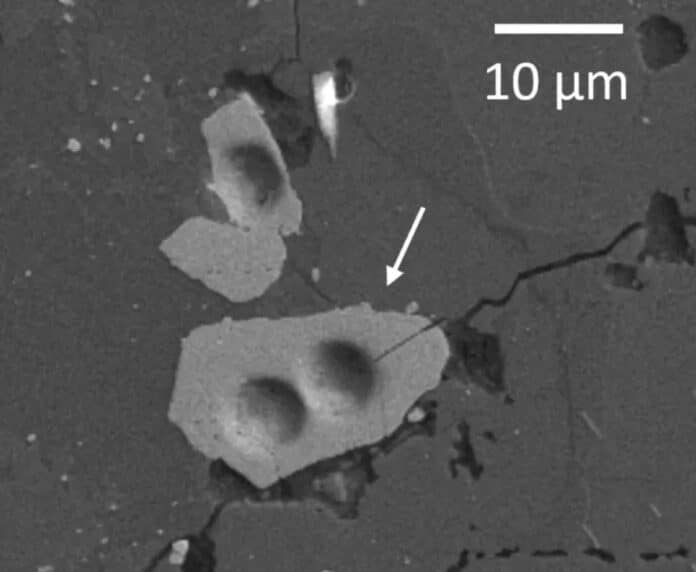A massive asteroid roughly the size of Mars collided with Earth more than 4 billion years ago, during the early stages of the Solar System and the planet’s growth. Our Moon was created by the largest fragment of the early Earth to break apart. But the exact time that this occurred is still unknown.
In a recent study published in Geochemical Perspectives Letters, scientists determined the Moon’s genesis date using crystals that Apollo astronauts returned from the Moon in 1972. Their findings update the Moon’s age to at least 4.46 billion years, or 40 million years, earlier than previously thought.
Jennika Greer, now a research associate at the University of Glasgow, said, “Our coauthors approached us, Bidong Zhang and Audrey Bouvier, who needed a nanoscale look at these samples to understand them fully.”
During the last crewed mission to the Moon in 1972, Apollo 17 astronauts returned with a sample of lunar dust used in the study. Tiny crystals developed billions of years ago can be found in this dust. These crystals provide a clear indicator of the Moon’s formation date.
When the massive object collided with Earth, the energy of the impact melted the rock that eventually became the Moon’s surface. Zircon crystals could not form and sustain on such a molten surface. So, any crystals on the Moon’s character must have developed after this lunar magma ocean cooled. If not, their chemical traces would have been lost due to melting.
The age of the zircon crystals would indicate the earliest possible age of the Moon since the crystals had to develop after the magma ocean cooled. This age has been proposed in a prior work by coauthor Bidong Zhang. Still, the most recent study is the first to employ the analytical technique known as atom probe tomography, which “nailed down” the age of the oldest known lunar crystal.
Greer said, “In atom probe tomography, we start by sharpening a piece of the lunar sample into a very sharp tip, using a focused ion beam microscope, almost like a fancy pencil sharpener.”
“Then, we use UV lasers to evaporate atoms from the surface of that tip. The atoms travel through a mass spectrometer, and how fast they move tells us how heavy they are, which tells us what they’re made of.”
Utilizing equipment from Northwestern University, this atom-by-atom examination revealed the number of atoms that had undergone radioactive decay within the zircon crystals. An atom decays, losing some protons and neutrons and changing into other elements, when it has an unstable arrangement of protons and neutrons in its nucleus.
For example, lead is formed when uranium decays. The duration of this process has been determined by scientists, and they may choose the age of a sample by examining the ratio of distinct uranium and lead atoms, or isotopes, that are present in it.
Heck said, “Radiometric dating works a little bit like an hourglass. In an hourglass, sand flows from one glass bulb to another, with the time indicated by the accumulation of sand in the lower bulb. Radiometric dating works similarly by counting the number of parent atoms and the number of daughter atoms they have transformed into. The passage of time can then be calculated because the transformation rate is known.”
Based on the ratio of lead isotopes, the scientists calculated the sample’s age to be 4.46 billion years. The Moon must, therefore, be at least that old.
Having evidence that the rock you are holding is the oldest portion of the Moon we have discovered to date is incredible. It serves as a starting point for a great deal of Earth-related queries. Knowing something’s age helps you better comprehend the events that have occurred in its past.
Based on the ratio of lead isotopes, the scientists calculated the sample’s age to be 4.46 billion years. The Moon must, therefore, be at least that old.
Having evidence that the rock you are holding is the oldest portion of the Moon we have discovered to date is incredible. It serves as a starting point for a great deal of Earth-related queries. Knowing something’s age helps you better comprehend the events that have occurred in its past.
Heck said, “It’s important to know when the Moon formed, because “the Moon is an important partner in our planetary system– it stabilizes the Earth’s rotational axis, it’s the reason there are 24 hours in a day, it’s the reason we have tides. Without the Moon, life on Earth would look different. It’s a part of our natural system that we want to understand better, and our study provides a tiny puzzle piece in that whole picture.”
Journal Reference:
- J. Greer, B. Xhang, D. Isheim et al. 4.46 Ga zircons anchor chronology of lunar magma ocean. Geochemical Perspectives Letters. DOI: 10.7185/geochemlet.2334
